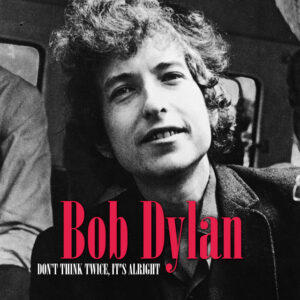October 31, 2025 —– Chart #322
Howdy Music Friends,
Sometimes a song comes along that feels like a private late-night conversation—sharp, honest, and just a bit bittersweet. That’s what Bob Dylan served up with “Don’t Think Twice, It’s All Right.” A song wrapped in folk tradition, complete with a folk-picking melody, and words that feel like they were scooped right out of a broken heart.
Bob wrote this one in 1962, during a quiet but tense moment—when his then-partner, Suze Rotolo, was heading off to study in Italy for six months. The song was his way of talking himself into being okay with it. He borrowed the melody and even some lines from a pal’s lament, “Who’s Gonna Buy You Ribbons (When I’m Gone),” and turned it into something all his own.
He cut this gem on November 14, 1962, at Studio A in Columbia Recording Studios in New York, and it hit the world when The Freewheelin’ Bob Dylan dropped in May 1963. It rode into listeners’ hearts just as the A-side “Blowin’ in the Wind” took off, and the two became a powerful one-two punch.
Then, just like that, Dylan’s quiet heartbreak got a big boost. Peter, Paul and Mary released their version in 1963, leaning into the harmonies and emotion, and turned it into a Top-10 hit—climbing to No. 9 on the Billboard Hot 100 and hitting No. 2 on the Easy Listening chart, which helped the song anchor itself in the pop mainstream. For a while, it seemed half the folk world was putting their own stamp on it—Joan Baez, Jackie DeShannon, Bobby Darin, and Waylon Jennings each took a turn, and near the end of his career Merle Haggard recorded this song as a duo with Willie Nelson.
The real power behind this song? In Dylan’s own words, it “isn’t a love song.” It’s more like a self-soothing mantra after your world shifts. He admitted in studio notes it’s hard to sing, because it’s not sweeping or romantic—it’s raw. And that’s exactly how it lands: you feel every bit of that weary acceptance as he repeats that refrain: “I ain’t sayin’ you treated me unkind… Don’t think twice, it’s all right.”
Over the years, the song has floated through generations—everyone from folk purists to jazz pickers to rock gods finding a layer or two in its simple chord structure. Odd covers keep popping up—like a jazzy instrumental version with both Glen Campbell and Hal Blaine playing behind it! But it’s Dylan’s original, the one from that early Freewheelin’ session, that still rings out as the blueprint for folk confessionals.
If you’ve ever loved, lost—or tried to convince yourself you’re fine while talking to the empty side of the bed—this one’s worth another listen.
Keep Rockin’,
Stan Bradshaw
If you don’t know Billy Strings . . . You should:
